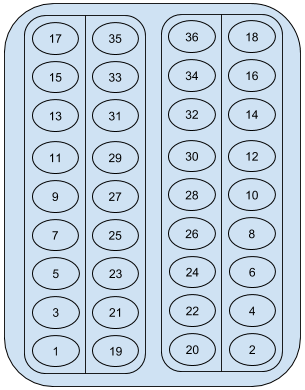2368.Seating On Bus
Time Limit: 1s Memory Limit: 256MBConsider 2n rows of the seats in a bus. n rows of the seats on the left and n rows of the seats on the right. Each row can be filled by two people. So the total capacity of the bus is 4n.
Consider that m (m \le 4n) people occupy the seats in the bus. The passengers entering the bus are numbered from 1 to m (in the order of their entering the bus). The pattern of the seat occupation is as below:
1-st row left window seat, 1-st row right window seat, 2-nd row left window seat, 2-nd row right window seat, ... , n-th row left window seat, n-th row right window seat.
After occupying all the window seats (for m \gt 2n) the non-window seats are occupied:
1-st row left non-window seat, 1-st row right non-window seat, ... , n-th row left non-window seat, n-th row right non-window seat.
All the passengers go to a single final destination. In the final destination, the passengers get off in the given order.
1-st row left non-window seat, 1-st row left window seat, 1-st row right non-window seat, 1-st row right window seat, ... , n-th row left non-window seat, n-th row left window seat, n-th row right non-window seat, n-th row right window seat. The seating for n=9 and m=36.
The seating for n=9 and m=36.
You are given the values n and m. Output m numbers from 1 to m, the order in which the passengers will get off the bus.
Input Format(From the terminal/stdin)
The only line contains two integers, n and m (1 \le n \le 100,1 \le m \le 4n) - the number of pairs of rows and the number of passengers.
Output Format(To the terminal/stdout)
Print m distinct integers from 1 to m - the order in which the passengers will get off the bus.